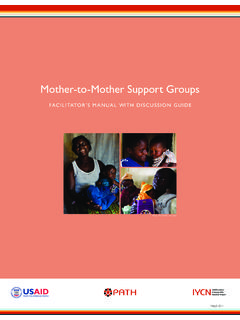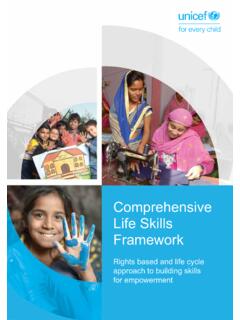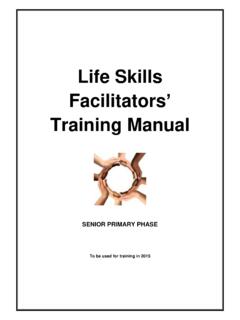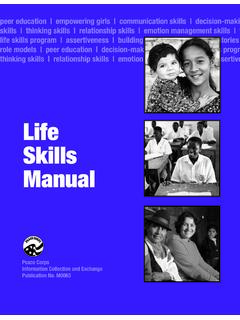Transcription of Standards-Based Life Skills Curriculum - A Day In Our Shoes
1 HBMSSC Standards-Based life Skills Curriculum Table of Contents Acknowledgements and English/Language Social Social Motor Functional Vocational Community- based Standards-Based life Skills Curriculum HBMSSC Standards-Based life Skills Curriculum PAGE 1 Acknowledgements This Standards-Based life Skills Curriculum document is the result of many hours of hard work during the 2006-2007 academic year by dedicated teachers of students with moderate disabilities within the Hamilton-Boone-Madison Special Services Cooperative. Sarah Ebersole Carmel High School Carmel Clay Schools Melissa Roesch Carmel High School Carmel Clay Schools Tracie Smoot Carmel High School Carmel Clay Schools Donna Wynn Clay Middle School Carmel Clay Schools Laura Brown Creekside Middle School Carmel Clay Schools Melanie Henn Cherry Tree Elementary Carmel Clay Schools Charone Lesher Mohawk Trails Elementary Carmel Clay Schools Susie Russ Mohawk Trails Elementary Carmel Clay Schools Abigail Johnson Towne Meadow Elementary Carmel Clay Schools Alison Rubel West Clay Elementary Carmel Clay Schools Peggy Loeffler Woodbrook Elementary Carmel Clay Schools Ellen Hammond Frankton High School Frankton Lapel School Corp.
2 Kristie Lofland Supervisor of Staff Development/Autism Consultant Hamilton Boone Madison Special Services Terri Miller Child Services Coordinator Hamilton Boone Madison Special Services Joyce Peters Transition Coordinator Hamilton Boone Madison Special Services Sara Petrites School Psychologist Hamilton Boone Madison Special Services Beth Tulbert Staff Development Coordinator Hamilton Boone Madison Special Services Chrissy Collesano Hamilton High School Hamilton Southeastern Schools LaBella Wallace Hamilton Heights High School Hamilton Heights Community Schools Julie Miller Noblesville High School Noblesville School Cathy Sculthorp Noblesville Middle School Noblesville Schools Cathy Wilkenson Hinkle Creek Elementary Noblesville Schools Rosanne Cherry Hinkle Creek Elementary Noblesville Schools Kim Lockhart Massaro Westfield High School Westfield Washington Schools Beth Purcell Westfield Middle School Westfield Washington Schools Colleen Webster Washington Woods Elementary Westfield Washington Schools HBMSSC Standards-Based life Skills Curriculum PAGE 2 Introduction With the implementation of the Individuals with Disabilities Education Improvement Act, focusing on an individualized educational plan for students with disabilities, and No Child Left Behind, which requires all students to work on and towards common state academic standards , educators and professionals working with students with moderate disabilities face a dilemma.
3 How do we individualize students educational programs and work towards a set of common academic standards ? This Standards-Based life Skills Curriculum has been developed in response to this dilemma. In curricular planning for students with more significant needs, it is noted that the general education Curriculum provides a resource base of standards and indicators for all students. However, it is inappropriate to hold students with moderate and multiple disabilities to all the same academic standards as students of the same age who are fully participating in the general education Curriculum . As there are no adopted state national standards for students with moderate disabilities, it is incumbent on schools to develop curricula that maintain high expectations for students, provide appropriate environment and time in which to practice Skills , allow flexibility to address individual differences, and support students in becoming as independent as possible while becoming contributing members of adult society once they leave the public school setting.
4 Organizationally, a school should have in place a Curriculum that can be implemented in classrooms and community- based instructional settings. A variety of resources were used in compiling this Standards-Based life Skills Curriculum : 1. The Indiana Academic standards Language Arts, Math, Science, Social Studies, Health, and Physical Education, Indiana Skills for Career and Technology Education, Business Technology Education Indicators, and Business, Marketing, and Information Technology Indicators) 2. The Functional indicators in the Indiana Supplemental Tools for Alternative Assessment (ISTAR) 3. The Indiana Early Childhood Foundations (Math, Language Arts, Science, Social Studies, Physical Education and Health, and Motor) 4. The Indiana Universal Indicators for Students in Guidance Indicators from the Early Childhood Foundations, the Indiana standards Tool for Alternate Reporting, Universal Indiana Student standards for Guidance, Indiana Academic standards were chosen based on the typical developmental and cognitive-functioning levels of students served within the life Skills classrooms.
5 The indicators included in the Curriculum are the key basic Skills needed as students transition into low-supported or independent functioning within the community where each individual will live, learn, work and play. The Standards-Based life Skills Curriculum is divided into seven different strands which are based on the content from each of the sources that were used when developing the Curriculum . Because of the many different cognitive, physical, medical, communication, and social needs of these students, there is no one set of traits shared by all. Each child is an individual. However, there are general issues around which educational instruction should be based in order for each student to reach his/her full potential. For instruction to be effective, schools must provide x age-appropriate activities and materials, x cognitively-appropriate instructional strategies, x immediate feedback and numerous opportunities to practice Skills , x opportunities to maintain and generalize Skills , x physical, visual, and verbal prompts, x useful technology and assistive devices, x opportunities to socialize with non-disabled peers, x a developmentally-appropriate functional skill continuum, and x a developmentally-appropriate community- based instruction continuum.
6 HBMSSC Standards-Based life Skills Curriculum PAGE 3 Practice and mastery of the specific Skills in each of the following Curriculum areas will provide students the opportunity to x demonstrate independence; x demonstrate self-advocacy Skills ; x engage in social interaction; x access community resources; x acquire and maintain vocational placement, and x participate in recreation and leisure activities. EXPLANATION OF EACH COLUMN Indicators: Indicators from the Indiana Academic standards K-12, the ISTAR continua, and the Foundations to the Indiana Academic standards for Children Birth to Age Five were chosen based on the typical developmental and cognitive-functioning levels of students served within functional life Skills classrooms.
7 The indicators and Skills included within each area of the Curriculum are the key basic Skills needed by these students as they transition to the next level. Strategies: The strategies listed in this section can be used to assist teachers in determining best-practice methods of providing instruction to students. These strategies should be chosen based on the individual needs of the student. Suggested Materials and Resources: This section contains a collection of existing materials and resources that special educators may utilize based on district availability. These materials and resources were compiled by the special educators responsible for the development of this Curriculum based on materials and resources available in their classrooms. Assessments: Data collection is an integral part of determining whether or not instruction and interventions are effective.
8 In order to collect data to reflect student performance and assess student needs, it is necessary to select both appropriate formative and summative assessments. Formative assessment refers to those assessments that provide ongoing information on student progress, while summative assessments aim to evaluate the efficacy of instructional methods and interventions. Examples of formative assessments include task analysis, teacher observations using teacher checklists, anecdotal records, ISTAR baseline scores and permanent product. Examples of summative assessments include ISTAR summary reports and portfolios. Student portfolios are collections of student work and assessments used to illustrate current levels of performance across areas of Curriculum . Examples of materials contained within student portfolios may include, but are not limited to, academic worksheets, handwriting samples, examples of cutting and coloring along with task analyses and anecdotal data.
9 Each student s portfolio should contain dated pieces from the beginning, middle and the end of each school year indicating level of independence. HBMSSC Standards-Based life Skills Curriculum PAGE Focus of English/Language Arts within the Standards-Based life Skills Curriculum Students participating in the Standards-Based life Skills Curriculum will acquire and demonstrate specific English/Language Arts Skills based on the Indiana Academic standards and indicators in the areas of: x Word recognition x Fluency x Vocabulary development x Comprehension and Analysis of Nonfiction and Informational Text x Comprehension and Analysis of Literary Text x Writing Processes and Concepts x Writing applications x Written English Language Conventions x Listening and speaking Skills , strategies and applications Early Childhood (Ages 3-5) x Looks at a book turning one page at a time.
10 X Identifies five common signs and symbols x Recognizes pictures of familiar people, places, and things. x Use symbols or objects to communicate x Attempt to write and draw x Communicates using one-two word vocalizations, signs, symbols, or gestures x Attends to adult directed activities or stories. x Initiate turn taking in play and conversations Primary (Grades K-2) x Read and identify letters of first name x Identify the front cover, back cover, and title page of a book x Identify a favorite story x Identifies two characters that interact in a story x Write by moving from left to right and from top to bottom x Imitates drawing of vertical, horizontal, and circle x Follow one-step spoken directions with prompts x Give [first and last] name, age, and gender upon request Intermediate (Grades 3-5) x Recognize and name all capital and lowercase letters of the alphabet x Read one-syllable and high-frequency (often-heard) words by sight.








